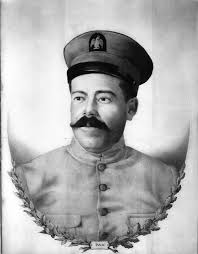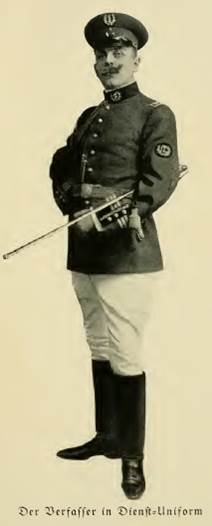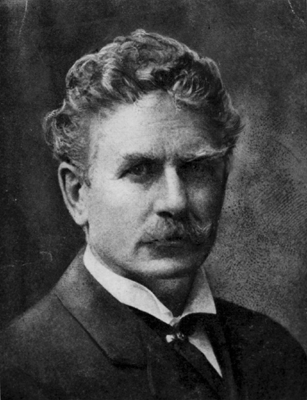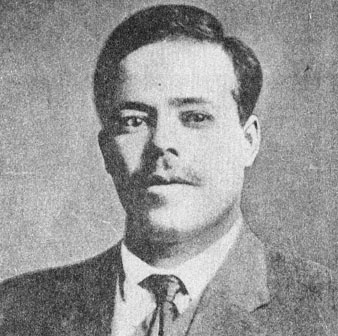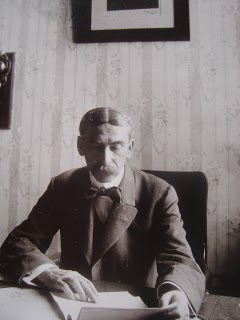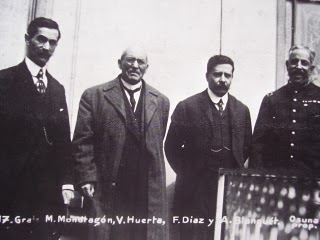The outline for this immense crime has its beginnings in the days after the assassination of the Austrian crown prince and his wife, exactly 100 years ago, on the 28th of June, 1914. Austria immediately accused Bosnia’s neighboring government of Serbia of having planned the killing. Since tensions between Serbia and Austria had been running high, the international community accepted this accusation as a likely possibility. The remedy the major European governments - France, Great Britain, and Russia - openly supported was for Serbia to apologize and accommodate Austria with whatever reasonable reparations it demanded. Clearly, Serbia had financed nationalistic societies in Bosnia-Herzegovina to fuel a popular uprising against the Austro-Hungarian Empire’s occupation. The crisis seemed minor and its diplomatic resolution easy. Nobody in the days after the double murder envisioned anything but a quick conclusion to the issues at stake. Except one government: The German Empire saw her chance to make strategic use of this crisis. With her allies, the Austro-Hungarian Empire and the Ottoman Empire, Germany wanted to advance her drive to control the Balkans, have access to the Mediterranean, Asia Minor, the Dardanelles, and the important trade routes to Egypt, India, and China. That desire put the German Empire squarely into Russia’s sphere of interest. The Czar had long supported Serbia against German and Austrian attempts to take over the Balkans.
On the day after the attack in Sarajevo, the Austrian Foreign Minister, Count Leopold von Berchthold, met with Franz Conrad von Hoetzendorf, the Austrian Chief of the General Staff. Von Hoetzendorf advocated a preemptive war against Serbia and painted the scenario of a quick demise of the Austro-Hungarian Empire through revolution if Serbia was not subdued.[1] Von Berchthold rejected the idea. He wanted to find a diplomatic solution, whereby Serbia would give in to strict Austrian demands that would effectively end subversion in Bosnia. On the next day, 30th of June 1914, German Ambassador Heinrich von Tschirschky reported von Berchthold’s attitude towards Serbia to German Chancellor Theobald von Bethmann Hollweg. In the margins of the report Emperor Wilhelm II noted ominous comments:
Tschirschky: “I frequently hear expressed here, even among serious people, the wish that at last a final and fundamental reckoning should be had with the Serbs.” William’s comment: “Now or never.”[2] Tschirschky: “I take opportunity of every such occasion to advise quietly but very impressively and seriously against too hasty steps.” William’s comment: “Let Tschirschky be good enough to drop this nonsense! The Serbs must be disposed of, and that right soon!”[3]
On the 2nd of July, Saxony’s envoy in Berlin updated his superior on the diplomatic developments in Berlin. He reported that, according to the German Foreign Office,
“…a war between Austria-Hungary and Serbia will consequently be avoided. Should it break out nonetheless, Bulgaria would immediately declare war on Greece…Russia would mobilize and world war could no longer be prevented. There is renewed pressure from the military for allowing things to drift towards war while Russia is still unprepared, but I don’t think that His Majesty the Kaiser will allow himself to be induced to do this.”[4]
The Saxonian diplomat outlined exactly what happened a month hence! While the German government tried its best to hide the conversations that took place in the halls of its chambers in the beginning of July, this lower level Saxonian official very accurately recorded the echoes of the unspeakable nonchalance with which Germany’s rulers set the world on fire. German historian Immanuel Geiss wrote:
“After the Kaiser had come down on the side of the General Staff, the political leaders fell in with the Monarch’s commands, in accordance with time-honoured German tradition, and, contrary to their earlier and better judgment, assumed responsibility for the diplomatic implementation of the new line… On 4 July in Berlin all confusion and divergencies [sic] over the course of Imperial policy in the July crisis which was now unfolding were henceforth put aside. The Kaiser had decided on war against Serbia even before he knew whether that was what the Austrians really desired…”[5]
On July 5th, Emperor Wilhelm II sent a message to the Austrian government via her ambassador that in case of war with Russia, Germany would lend full support to her ally.[6] The Austrian ambassador reported to Berchthold on July 6th,
“With regard to our relations towards Serbia the German Government is of [the] opinion that we must judge what is to be done to clear the course [towards war]; whatever we may decide, we may always be certain that we will find Germany at our side…In the further course of conversation I ascertained that the Imperial Chancellor like his Imperial master considers immediate action on our part as the best solution for our difficulties in the Balkans. From an international point of view he considers the present moment as more favorable than some later time…”[7]
However, the Austrians had more scruples than her German ally would have wished for. The German Minister of War Erich von Falkenhayn confided to the Chief of the General Staff Helmut von Moltke on July 5th that he had little faith in Austria’s willingness to jump off the cliff. “The Chancellor [von Bethmann Hollweg]…appears to have as little faith as I [Falkenhayn] do that the Austrian Government is really in earnest…”[8] The biggest stepping stone in Germany’s efforts to coax her ally into a world war was Count von Tisza, the Hungarian prime minister. He refused to have Austria-Hungary be pushed into war and insisted that a list of demands be drafted to the Serbian government. Only if these demands were not met, would he agree to further escalation of the crisis.[9] The German emperor commented on Count von Tisza’s attitude with a quote taken from his most famous ancestor, Frederick the Great: “I am against all councils of war and conferences, since the more timid party always has the upper hand.”[10] Worse for the German urgency, Austria-Hungary required a minimum of sixteen days to mobilize.[11]
If there were any doubts as to what would happen in case of a war with Russia, the British Foreign Secretary Sir Edward Grey dispersed those on July 9th. He told the German ambassador to Great Britain in no uncertain terms that England would not “be found on the side of the aggressors in the event of continental complications.”[12] Secretary Grey’s statement was ambivalent. Would England join the continental powers in a war against Germany? The German government interpreted the comment as England’s intention to remain neutral in case of a continental war. Albert Ballin, the director of the HAPAG (Hamburg-Amerikanische-Paketfahrt-Aktien-Gesellschaft), tried to clarify the British attitude in case of war for the German government. Between July 23rd and 27th, Ballin attended meetings with Secretary Grey and Winston Churchill among others and reported back to his friend, Emperor Wilhelm II, “Britain has no reason and the highest circles in Britain, it is certain, see no reason for currently preparing for the event that Britain has to take part actively in an armed conflict.”[13] As a result Chancellor von Bethmann Hollweg and Foreign Secretary von Jagow actively pursued “localization” as a course of action. Localization was the insane belief that, since Britain would be neutral and France “burdened at the present time with all sorts of troubles,” the intended strike against Serbia would remain a bilateral conflict.[14] Russia, von Bethmann Hollweg believed, would not risk a war with Germany if the other great powers of Europe remained on the sidelines. The utter misinterpretation of the international situation, unless wonton, allows only one conclusion: von Bethmann Hollweg, the chain-smoking head of the German government in those hot days of the Berlin summer, seemingly suffered from delusions. Emperor Wilhelm II astutely remarked in the margins of an Austrian telegram to Foreign Secretary von Jagow, “Austria must become preponderant in the Balkans as compared with the little ones, and at Russia’s expense…”[15] On July 24th, Sir Edward Grey told the German ambassador in no uncertain terms “that a war between Austria and Serbia cannot be localized.”[16]
On the afternoon of July 23rd, timed so that French President Raymond Poincaré and his Prime Minister René Viviani were on the way back from a state visit to Russia, the Austrian ambassador submitted an ultimatum to the Serbian government. [17] The ultimatum had been drafted with input and agreement from Berlin. Chancellor von Bethmann Hollweg, Secretary von Jagow and his aides pushed Austrian officials to design the wording so that it would be unacceptable to Serbia.[18] The Hungarian prime minister and last voice of reason in the Austro-Hungarian cabinet meetings, Count von Tisza, had caved under pressure. The final version submitted to Serbia demanded a cessation of Pan-Slav propaganda, including the shutting down of any publication and organization that promoted such. Specifically Austria wanted the “Narodna Odbrana” (National Defense) outlawed. This Serbian organization operated in Bosnia spreading anti-Austrian propaganda. Its paramilitary wing, the “Black Hand,” also engaged in terrorism and was thought to have planned and executed the assassination. Serbia was to dismiss any personnel, military or civilian, involved in subversion against Austria. Any propaganda in Serbian school curricula and textbooks had to disappear. Serbia should initiate a judicial inquiry against anyone who participated in the assassination plot. The Austro-Hungarian Empire would send prosecutors to participate in the legal proceedings. Austria also demanded the arrest of two Serbian officials who were allegedly implicated. Serb officials should further prevent the smuggling of arms and explosives across its borders to Bosnia. Specific border officials that had been implicated should be dismissed and tried. Serbia had forty-eight hours to respond.[19]
Serbia, after an initial shock, surprised the world when she responded to the ultimatum in a spirit of cooperation. Under diplomatic pressure from France, England, and Russia, Serbia agreed to all Austrian demands except for two, which flagrantly violated Serbian sovereignty.
“As far as the cooperation in this investigation of specially delegated officials of the I. and R. Government is concerned, this cannot be accepted, as this is a violation of the constitution and of criminal procedure. Yet in some cases the result of the investigation might be communicated to the Austro-Hungarian officials … The Royal Government confesses that it is not clear about the sense and the scope of that demand of the I. and R. Government which concerns the obligation on the part of the Royal Serbian Government to permit the cooperation of officials of the I. and R. Government on Serbian territory, but it declares that it is willing to accept every cooperation which does not run counter to international law and criminal law, as well as to the friendly and neighbourly relations.”[20]
Sir Edward Grey as well as other European leaders expected the Serbian response to satisfy Austria. Serbia even signaled the day after her response that certain points in the response to Austria could be modified to further accommodate the complete acceptance of the demands.
“Sir Edward Grey to the German Ambassador.
July 25, 1914.
Dear Prince Lichnowsky
I enclose a forecast that I have just received of the Servian reply. (1) It seems to me that it ought to produce a favourable impression at Vienna, but it is difficult for anybody but an ally to suggest to the Austrian Government what view they should take of it.
I hope that if the Servian reply when received in Vienna corresponds to this forecast, the German Government may feel able to influence the Austrian Government to take a favourable view of it.
Yours sincerely,
E. GREY.”
An Austrian rejection of the Serbian reply signaled to the rest of Europe what indeed was the case: The whole crisis had been a pretext and, as Sir Edward Grey told the German ambassador on the 27th of July, “Austria was only seeking an excuse for crushing Serbia. And thus that Russia and Russian influences in the Balkans were to be struck at through Serbia.”[22]
Austria not only rejected the reply, but did so without even reading it. Scanning the document, Austrian ambassador to Belgrade, Giesl, without further consultation broke off diplomatic relations, got on the train, and entered Austrian territory that same evening.[23] Already that afternoon, the Serbian army had mobilized along the Austro-Hungarian border and begun to evacuate Belgrade, which was in shooting range from across the border. Austria mobilized the next day, egged on by the German emperor who wanted hostilities to begin immediately. Great Britain, however, did not give up on her efforts to save the world from plunging into war. Not realizing the extent to which Germany was pushing the war, Sir Edward Grey asked Wilhelm II to intervene with Austria in order to win participation in an international mediation process. Germany submitted the request to Vienna, however, included was a commentary asking Austria not to react.[24]
While the British foreign secretary tried his best to prevent the imminent “conflagration,” the last real chance to maintain peace came from an unlikely quarter. The man who had directed his cabinet to create a world war, who had pushed the Austrian emperor to be decisive and unyielding, now got cold feet. On July 28th, in a handwritten note to Foreign Secretary von Jagow, Emperor Wilhelm II admitted: “I am convinced that on the whole the wishes of the Danube Monarchy have been acceded to. The few reservations that Serbia makes in regard to individual points could, according to my opinion, be settled by negotiation.”[25] The grandson of Queen Victoria, the cousin of Czar Nicholas, the man who had fired Chancellor Prince Bismarck, had set Europe on fire and now, as the flames shot up into the sky, he began to see the inevitable existence of his imperial fingerprints on the criminal diplomacy of July 1914. Although it took historical forensics until the 1960s to fully understand the detailed circumstances of the outbreak of the Great War, British, Italian, French, and American diplomats knew the truth. The guilt for the world war lay squarely in the lap of the Austrian and German governments.
On that day, July 28th 1914, the massive armies that had assembled all across Europe took on an unstoppable dynamic. Austria invaded Serbian territory in the morning of that fateful day. Russia mobilized its armies on the next day, two days later full mobilization orders swept through German barracks. On August 1st, Germany declared war against Russia. The ball so aptly described by the Saxonian official barely a month ago now started rolling. France and England joined the war within a week in order to support Russia. Wilhelm’s misgivings had come too late. Still holding out for England’s neutrality Emperor Wilhelm II tried to modify the war planning. He ordered troop deployment on the western front to be halted and to only proceed on the Russian front. Professor Hans Delbrueck, an influential politician, military historian, imperial tutor, and fierce critic of Germany’s war strategy, encapsulated the dynamic of what the emperor had set in motion: “The final war plan … could not be altered... Deployment could not be stopped for technical reasons.”[27] Independent of the diplomatic situation leading up to mobilization, once set in motion, Germany had to attack France first, then Russia. On August 4th, German troops marched through neutral Belgium in order to circumvent the significant French fortifications along the German-French border. The attack plan unreeled statically.
The Schlieffen Plan, Germany’s war plan that formed the basis for a European war scenario with two fronts, proved to be fatally flawed. General Field Marshall Count Alfred von Schlieffen had developed his plan in 1905 as Chief of the General Staff. In its basic outline, von Schlieffen constructed a scenario in which Germany defeated France in a “Blitzkrieg” by outflanking her defending army along the Rhine. The plan called for the violation of Belgian and Dutch neutrality. The German forces were to march through Belgium into northern France and cut the critical supply lines to the North Sea ports. At the same time, a smaller portion of the German army would secure the eastern front while Russia mobilized.
The two main prerequisites for this war plan to work were British neutrality and the element of surprise that was to prevent France from stopping the German advance while Russia took her time to mobilize. Neither of these prerequisites fell into place. As a result of the Austro-Hungarian squabbles with Serbia, Russia partially mobilized on the 28th of July, three days before German mobilization. On August 4th, England declared war against Germany as a result of Germany’s violation of Belgium’s borders. Von Schlieffen, who had died in 1913, must have turned in his grave. The diplomatic work to prepare his war scenario had utterly failed. Wilhelm II and his military advisers received bogus information from Albert Ballin, Ambassador Prince Lichnowsky, Chancellor von Bethmann Hollweg, and Foreign Secretary von Jagow with respect to England’s resolve to not let Germany conquer Central Europe. Britain did join the Entente powers France and Russia, while an important German ally, Italy, bailed, and declared neutrality. Belgium offered serious resistance and slowed the German advance to a crawl. On the Russian front, Germany scored impressive victories in the first weeks of the war but none of the battles were decisive. The Russian armies kept up the pressure on Germany. The worst-case scenario, a two-frontal war with stagnant lines, had become a reality within weeks of Germany’s declarations of war against both France and Russia.
This is not the only interpretation of how the world plunged into war. Some have argued that all nations simply "stumbled" into war. Others have blamed the Russian Empire for having mobilized its armies, thus forcing the hands of Germany. Maybe we will never know for sure how it happened, which, in itself opens the possibility that we might once more "stumble." Whether the German Emperor and his chancellor precipitated the tragic turn of events, or whether recklessness, stupidity, arrogance, or greed characterized the leaders of the great powers in July 1914, which made it possible that a world indeed stumbled into the abyss, it does not really matter. What matters is that at the very least we all, responsible citizens of the world try to understand what happened, and make sure when leaders are elected, that the tragedy of July 1914 will never be allowed to repeat itself.
[1] Geiss, July 1914, p. 64 as quoted from Conrad von Hoetzendorf’s Memoires, Vol. IV, pp. 33.
[2] Geiss, July 1914, p. 64, Tschirschky to Bethmann Hollweg, Report 212, June 30, 1914.
[3] Geiss, July 1914, p. 65, Tschirschky to Bethmann Hollweg, Report 212, June 30, 1914.
[4] Geiss, July 1914, p. 68, Lichtenau to Vitzthum, Report 1045, July 2, 1914. The attitude of the military is documented in entry from the diary of Georg Alexander von Müller (December 8, 1912). Bundesarchiv fuer Militaergeschichte, Freiburg, Barch N 159/4 Fol. 169-171. In this meeting Tirpitz, Moltke, and Heeringen discussed the inevitability of a two frontal war against France-England in the west and Russia in the east.
[5] Geiss, July 1914, pp. 62-63.
[6] The so-called blank check. See Die Österreichisch-Ungarischen Dokumente zum Kriegsausbruch, hrsg. vom Staatsamt für Äußeres in Wien, National-Verlag, Berlin, 1923, Telegram 237, Count Szögyény to Count Berchtold, July 5, 1914.
[7]{C} Die Österreichisch-Ungarischen Dokumente zum Kriegsausbruch, Count Szögyény to Count Berchtold, July 6, 1914.
[8] Geiss, July 1914, p. 78, Falkenhayn to Moltke, July 5, 1914.
[9]{C} Die Österreichisch-Ungarischen Dokumente zum Kriegsausbruch, Ministerrat für gemeinsame Angelegenheiten, July 7, 1914.
[10] Geiss, July 1914, p. 108, Tschirschky to Jagow, July 10, 1914.
[11] Geiss, July 1914, p. 103, Tschirschky to Jagow, July 8, 1914.
[12] Geiss, July 1914, p. 104, Lichnowsky to Bethmann Hollweg, July 9, 1914.
[13] As quoted in Johannes Gerhardt, Albert Ballin, Hamburg University Press, Hamburg, 2010.
[14] Geiss, July 1914, p. 118, Bethmann Hollweg to Roedern, July 16, 1914.
[15] Geiss, July 1914, p. 181, Tschirschky to Jagow, #101, July 24, 1914.
[16] Geiss, July 1914, p. 216, Minutes of Clerk, Crowe, Nicolson and Grey on the German note of 21/24 July, July 25, 1914.
[17] The return trip via Sea route took the two most important members of the French government out of communication until July 29th, the day after the Austrian declaration of war against Serbia. Only on July 25th at a brief stop in Sweden was Poincare able to give more detailed instructions to his cabinet.
[18] Geiss, July 1914, p. 134.
[19] Die Österreichisch-Ungarischen Dokumente zum Kriegsausbruch, Count Berchtold to Freiherrn von Giesl in Belgrad, July 20, 1914.
[20] Die Österreichisch-Ungarischen Dokumente zum Kriegsausbruch, Note der königlich serbischen Regierung vom 12./25. Juli 1914, July 25, 1914.
[21] G.P. Gooch, D. Litt, and Harold Temperley, editors, British Documents on the Origins of the War, 1898-1914, Vol. XI: The Outbreak of War: Foreign Office Documents, June 28th-August 4th, 1914, His Majesty's Stationery Office, 1926, Grey to Lichnowsky, July 25, 1914.
[22] Geiss, July 1914, p. 238, Lichnowsky to Jagow, Telegram #164, July 27, 1914.
[23] Die Österreichisch-Ungarischen Dokumente zum Kriegsausbruch, Freiherr von Giesl to Count Berchtold, July 25, 1914.
[24] Die Österreichisch-Ungarischen Dokumente zum Kriegsausbruch, Count Szögyény to Count Berchtold, July 27, 1914.
[25] Geiss, July 1914, p. 256, Wilhelm II to Jagow, July 28, 1914.
[26] Dr. Delbrueck tutored to the son of the Prussian crown prince, Prince Waldemar from 1874 to 1879.
[27] Hans Delbrück, Arden Bucholz ed., Delbrück's modern military history, University of Nebraska Press, Lincoln, NE, 1997, pp. 25-26.







